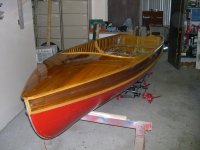That’s pretty decent rates my winter is $2200 and that includes crane in/out . I pull and install mast so that saves $700. Dock is $130ft in Oakville so $3900. I’m about 8k unless we buy a sail of two , they average 3-4K . It’s not cheap but I am at the bottom of the food chain right now . At a point doing something like Charleston or KeyWest was 10-12k for a week . This is less fun , but I can afford it .
Sent from my iPhone using GTAMotorcycle.com
Sent from my iPhone using GTAMotorcycle.com

















